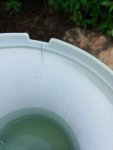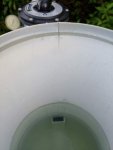Hi friends.
I JUST bought a 9lb. in-line chlorinator from Leslie's (they didn't carry Hayward - and they looked to be pretty much the same thing. Let me know if I'm wrong.)
While trying to open it (before I noticed there was a tab to press to allow the cap to turn), I heard a crack - but investigated and didn't see anything.
Few days later, pool man installs for us - turn on the pump, we have LOADS of bubbles coming into the pool through the jets.
After reading on here, I suspected a suction-side air leak. I have a Hayward pump with the black lid so you can't see anything - no clue if there are air bubbles in the actual pump.
No bubbles or whirlpool in the skimmer, no blockage on main drain.
Tried turning off main drain line - still bubbles. Tried turning off skimmer line - still bubbles.
Tried using a water hose around all of the piping and plumbing slowly to see if anywhere I put it, the bubbles would go away or lessen. Nope.
Tried backwashing and rinsing the filter because I was running out of ideas - didn't help.
So, turned everything off - took the lid off the chlorinator and low and behold: two hairline cracks at the very top of the chlorinator - right across from each other, about an inch long, and in the area where the lid sits (you can't see them unless you take the lid off.) It was then that I realized I was smelling chlorine the whole time working to find the leak - (duh) from the pucks inside the chlorinator.
Is this a possibility of where the air leak is? I know it makes more sense for it to be suction side, and everything on the pressure side would be a water leak - but it's not leaking water at all, and the bubbles only started since installing it. (New pump was installed at the same time - I made sure to lube the o-rings inside both pump and chlorinator.
Help! What can I do?
Also, I'm in the process of SLAMing because our previous pump motor had finally given out on us - and it took 2 weeks for someone to get out here to replace it (ugh).
Will the bubbles affect the SLAMing process at all?
Thanks!
Erica
I JUST bought a 9lb. in-line chlorinator from Leslie's (they didn't carry Hayward - and they looked to be pretty much the same thing. Let me know if I'm wrong.)
While trying to open it (before I noticed there was a tab to press to allow the cap to turn), I heard a crack - but investigated and didn't see anything.
Few days later, pool man installs for us - turn on the pump, we have LOADS of bubbles coming into the pool through the jets.
After reading on here, I suspected a suction-side air leak. I have a Hayward pump with the black lid so you can't see anything - no clue if there are air bubbles in the actual pump.
No bubbles or whirlpool in the skimmer, no blockage on main drain.
Tried turning off main drain line - still bubbles. Tried turning off skimmer line - still bubbles.
Tried using a water hose around all of the piping and plumbing slowly to see if anywhere I put it, the bubbles would go away or lessen. Nope.
Tried backwashing and rinsing the filter because I was running out of ideas - didn't help.
So, turned everything off - took the lid off the chlorinator and low and behold: two hairline cracks at the very top of the chlorinator - right across from each other, about an inch long, and in the area where the lid sits (you can't see them unless you take the lid off.) It was then that I realized I was smelling chlorine the whole time working to find the leak - (duh) from the pucks inside the chlorinator.
Is this a possibility of where the air leak is? I know it makes more sense for it to be suction side, and everything on the pressure side would be a water leak - but it's not leaking water at all, and the bubbles only started since installing it. (New pump was installed at the same time - I made sure to lube the o-rings inside both pump and chlorinator.
Help! What can I do?
Also, I'm in the process of SLAMing because our previous pump motor had finally given out on us - and it took 2 weeks for someone to get out here to replace it (ugh).
Will the bubbles affect the SLAMing process at all?
Thanks!
Erica



